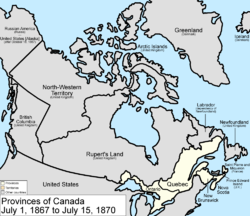History
On May 2, 1670, King Charles II of England granted the HBC a royal charter for "the sole Trade and Commerce of all those Seas, Streights, Bays, Rivers, Lakes, Creeks, and Sounds, in whatsoever Latitude they shall be, that lie within the entrance of the Streights commonly called Hudson's Streights... which are not now actually possessed by any of our Subjects, or by the Subjects of any other Christian Prince or State... and that the said Land be from henceforth... called Rupert's Land." [1] In addition to the grant of commercial rights, the Charter also stated that the grant was "together with all the Lands and Territories upon the Countries, Coasts and Confines of the Seas, Bays, Lakes, Rivers, Creeks, and Sounds aforesaid, that are not already actually possessed," and including "all mines Royal." [1] The basis of this claim and the charter was under the principle of the doctrine of discovery, whereby the lands were considered free to claim if they were not owned already by other European nations. The Supreme Court of Canada has held that the grant also gave the Company ownership of the resources within Rupert's Land. [2] [3]
Expansion
Using the doctrine of discovery, the British Parliament further extended the company's domain in 1821 to the North-Western Territory as well with the passage of "An act for regulating the fur trade, and establishing a criminal and civil jurisdiction within certain parts of North America." [4]
In 1867, with Confederation, the new Dominion of Canada sought to expand westward. In that same year, Canada's Parliament expressed this desire to the United Kingdom and soon after entered into talks with the HBC to arrange for the transfer of the territory. [5] These talks resulted in the Deed of Surrender, which was part of an order-in-council by the United Kingdom titled "Rupert's Land and North-Western Territory - Enactment No. 3: Order of Her Majesty in Council admitting Rupert's Land and the North-Western Territory into the union, dated the 23rd day of June 1870". The Deed was approved and issued on June 23, 1870, and took effect on July 15, 1870. [6] The Province of Manitoba, the first new province to join Confederation, was created on the same day.
This page is based on this
Wikipedia article Text is available under the
CC BY-SA 4.0 license; additional terms may apply.
Images, videos and audio are available under their respective licenses.

